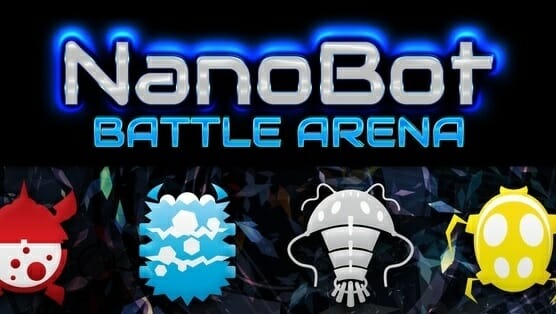NanoBot Battle Arena Boardgame

NanoBot Battle Arena—which we’ve just been calling NanoBots around the house the last few days as my wife, my daughter, and I all trash-talk each other between games—is another Kickstarter success story, funded in 2013 and released early last year. It’s a tile-laying game with an elegant twist: There are eight tile types, each associated with a specific Reaction card, and players use those cards to grow their tile chains more quickly or to break up or annihilate opponents’ tiles.
Players in NanoBot Battle Arena are scientists who have created and trained various strains of nanotech “bots” to fight in Petri dish-sized arenas, forming chains of bots while trying to break up or destroy opponents’ chains; the player with the longest unbroken chain at game-end, which occurs once one player has run out of tiles, is the winner. There are eight such strains, fifteen tiles apiece, and players can play one strain each in the basic game or two to four strains in an advanced game. The basic game, which has each player place one tile and play one Reaction card per turn, is too simple and functioned like a tutorial for us, after which we switched to games where each player played two strains rather than one. In these advanced games, where each player starts with 30, 45 or 60 tiles depending on how many strains s/he plays, turns are longer and allow for a little more strategy. On a single turn, a player plays one Reaction card from his/her hand of six, places two tiles, plays two more Reaction cards, and then draws new cards to return his/her hand to the full limit.
Tile placement is simple: The tiles, which might be cute except for the part about the nanobots looking like they’d cause some horrible parasitic diseases, have one “base edge” with arrows on it, which determines their direction for the construction of a chain. A player may place a tile anywhere on the table, in any orientation, except along the base edge of another player’s tile. Chains may turn, but are broken by empty spaces or by tiles with base edges turned in the wrong direction—that is, tiles that are adjacent are not automatically part of a chain.
The key mechanic that makes this more than just a tile-laying game is the Affinity that links tiles to Reaction cards. Every card has a number on it from 1 to 3, with 1 cards the most common and 3 the least so. Each of the eight tile colors connects to a specific color of Reaction card, and that card’s power is increased by one whenever that player uses that card type. A player may apply the effects of a card to his/her own tiles or to any opponents’ tiles, as long as those tiles aren’t “petrified”—flipped over via a Petrify card to protect them against all attacks. There are cards that destroy tiles, some that move tiles, and some that reorient them.
-

-

-

-

-

-

-

-

-

-

-

-

-

-

-

-

-

-

-

-

-

-

-

-

-

-

-

-

-

-

-

-

-

-

-

-

-

-

-

-









































